Epoetin beta pegol for treatment of anemia ameliorates deterioration of erythrocyte quality associated with chronic kidney disease
- PMID: 29374477
- PMCID: PMC5787256
- DOI: 10.1186/s12882-018-0818-4
Epoetin beta pegol for treatment of anemia ameliorates deterioration of erythrocyte quality associated with chronic kidney disease
Abstract
Background: Epoetin beta pegol (continuous erythropoietin receptor activator; C.E.R.A.) is currently widely used for the treatment of anemia associated with chronic kidney disease (CKD). Therapeutic control of anemia is assessed by monitoring haemoglobin (Hb) levels. However, certain qualitative aspects of erythrocytes are also impaired in CKD, including loss of deformability and shortened life-span. Therefore, monitoring Hb alone could potentially fail to reveal pathological changes in erythrocytes. Focusing on erythrocyte quality in CKD may lead to more effective anemia therapy with C.E.R.A.
Methods: A CKD rat model was induced by uninephrectomy followed by anti-Thy1.1 antibody injection. From 5 weeks after the operation, C.E.R.A. (0.6 μg/kg) or vehicle was administered every 2 weeks. Erythrocyte deformability was quantified with ektacytometry and erythrocyte turnover was estimated by biotin labeling. Intracellular calcium level was assessed by Fluo-3/AM.
Results: Erythrocyte deformability progressively declined in CKD rats. Furthermore, erythrocyte turnover in the circulation drastically accelerated in CKD rats. With administration of C.E.R.A. at a dose sufficient to adequately control Hb, deterioration of erythrocyte deformability and turnover in CKD rats were significantly improved. Intracellular calcium, which plays a pivotal role in the mediation of erythrocyte quality, was significantly increased in CKD and was normalized by C.E.R.A.
Conclusion: C.E.R.A. treatment exerted a favorable effect not only on anemia but also on the improvement of erythrocyte quality. C.E.R.A. administered for the treatment of CKD-associated anemia may confer therapeutic benefits on erythrocytes.
Keywords: Anemia; Chronic kidney disease (CKD); Epoetin beta pegol (C.E.R.A.); Erythrocyte deformability; Erythrocyte turnover; Hematopoiesis; Intracellular calcium.
Conflict of interest statement
Ethics approval
This study is a non-clinical research. All animal procedures and experimental protocols were approved by the Institutional Animal Care and Use Committee at Chugai Pharmaceutical Co., Ltd., and conformed to the Guide for the Care and Use of Laboratory Animals published by Institution of Laboratory Animal Resources (ILAR).
Consent for publication
Not applicable (no individual person’s data).
Competing interests
The authors declare that they have no competing interests.
Publisher’s Note
Springer Nature remains neutral with regard to jurisdictional claims in published maps and institutional affiliations.
Figures
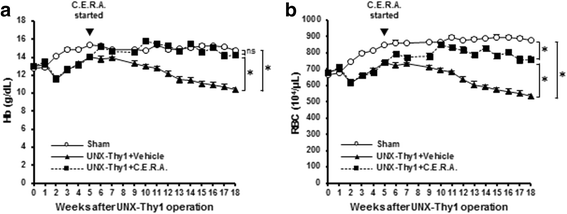
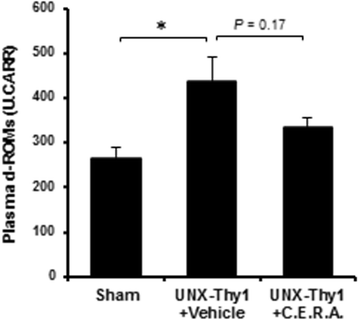
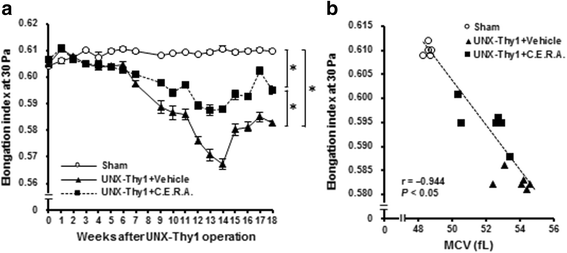
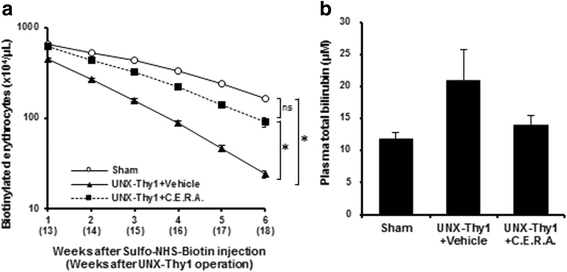
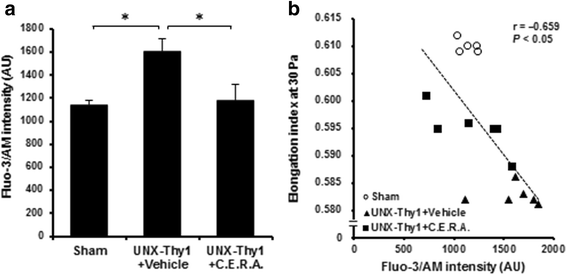
Similar articles
-
Epoetin beta pegol prevents endothelial dysfunction as evaluated by flow-mediated dilation in chronic kidney disease rats.Eur J Pharmacol. 2015 Nov 15;767:10-6. doi: 10.1016/j.ejphar.2015.09.034. Epub 2015 Sep 30. Eur J Pharmacol. 2015. PMID: 26432688
-
Effect of achieved hemoglobin level on renal outcome in non-dialysis chronic kidney disease (CKD) patients receiving epoetin beta pegol: MIRcerA CLinical Evidence on Renal Survival in CKD patients with renal anemia (MIRACLE-CKD Study).Clin Exp Nephrol. 2019 Mar;23(3):349-361. doi: 10.1007/s10157-018-1649-0. Epub 2018 Oct 5. Clin Exp Nephrol. 2019. PMID: 30291472 Free PMC article.
-
Epoetin beta pegol, but not recombinant erythropoietin, retains its hematopoietic effect in vivo in the presence of the sialic acid-metabolizing enzyme sialidase.Int J Hematol. 2016 Aug;104(2):182-9. doi: 10.1007/s12185-016-2000-8. Epub 2016 Apr 15. Int J Hematol. 2016. PMID: 27084258
-
Methoxy Polyethylene Glycol-Epoetin Beta as a Novel Erythropoiesis Stimulating Agent with Possible Nephroprotective and Cardiovascular Protective Effects in Non-Dialysis Chronic Kidney Disease Patients.Curr Pharm Biotechnol. 2017;18(4):303-308. doi: 10.2174/1389201018666170127104801. Curr Pharm Biotechnol. 2017. PMID: 28137221 Review.
-
Methoxy polyethylene glycol-epoetin beta: worth waiting for or a novelty worn off?Expert Opin Pharmacother. 2009 Jun;10(9):1509-14. doi: 10.1517/14656560902997982. Expert Opin Pharmacother. 2009. PMID: 19505218 Review.
Cited by
-
Excessive Erythrophagocytosis Accounts for Systemic Inflammation in Chronic Kidney Disease.J Inflamm Res. 2024 Oct 9;17:7111-7121. doi: 10.2147/JIR.S467136. eCollection 2024. J Inflamm Res. 2024. PMID: 39398228 Free PMC article.
-
Early responsiveness to continuous erythropoietin receptor activator predicts renal prognosis and is determined by a novel antioxidative marker in non-dialysis chronic kidney disease: a prospective, observational, single-center study.Clin Exp Nephrol. 2020 Jul;24(7):590-597. doi: 10.1007/s10157-020-01873-0. Epub 2020 Mar 17. Clin Exp Nephrol. 2020. PMID: 32185544
-
Lead Generation for a HIF Prolyl Hydroxylase Inhibitor: Discovery of (7-Hydroxy-[1,2,4]triazolo[1,5‑a]pyridine-8-carbonyl)glycine as a Lead Compound of Enarodustat.ACS Med Chem Lett. 2025 Apr 30;16(6):1124-1130. doi: 10.1021/acsmedchemlett.5c00172. eCollection 2025 Jun 12. ACS Med Chem Lett. 2025. PMID: 40529048
References
MeSH terms
Substances
LinkOut - more resources
Full Text Sources
Other Literature Sources
Medical
Miscellaneous

